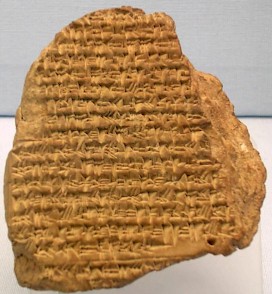Reading Cuneiform
The Assyrian and Babylonian Chronicles are historiographical texts from ancient Mesopotamia. Although they contain references to the earliest times, they deal especially with the second half of the second and the entire first millennium down to the first century BCE.

Cuneiform texts look complex and seem hard to read, and, frankly, they are complex and are hard to read. Yet, there are degrees of complexity and even a layman can make sense of a cuneiform text. For example, the Persian script is alphabetic and often used in clearly legible rock inscriptions. Because the texts are highly stereotypical, you can start to recognize the names of kings fairly soon.
Reading the Assyrian-Babylonian cuneiform characters, however, is a difficult job, even to specialists, and both the layman and the professional scholar have to settle for a critical edition made by someone who has meticulously studied the tablet. In fact, the same holds for Greek and Latin texts. Only a few classicists actually study the medieval manuscripts.
The difference is that cuneiform writing is not alphabetical but a mixture of ideograms (one sign is one word) and syllabic. If a tablet is only slightly damaged, complete words are illegible, and a surprisingly large part of modern scholarly literature is devoted to simple questions as "what is this or that sign?" (The advantage of the system is that small tablets can contain large texts.)
To make things worse, Babylonian cuneiform is based on an older system, Sumerian. One part of the inheritance is the use of Sumerian signs to indicate well-known words. For example, the word for king could be written with two signs, shar-ru, but in Sumerian cuneiform, only one sign is needed to write lugal. This is easier to write, and not incomparable to English abbreviations (e.g., AD, PS, NB) which we hardly recognize as renderings of Latin words. In a critical edition, sumerograms are indicated by CAPITALS.
This is, as noted, easier to write, and an experienced reader will not have found it difficult. To us, it is rather confusing. Now let's make things more complex and look at the signs to write variants of the word "king". For example, kingship, sharrutu, can be spelled as shar-ru-tu, but it was more common to write LUGAL-u2-tu: first, a sumerogram, then two signs to describe u and tu. (See below for the small 2.) Now, the advantage has gone: a word with three syllables needs three characters, and the use of a sumerogram is just the result of oversystematization (or pedantry).
Unfortunately, the same signs are used in different ways, as ideograms and as syllables. For example, KU can be read as TUKUL = sumerogram for "weapon", or syllabic as ku in Si-lu-ku = Seleucus. There is a damaged tablet that contains the signs
[damaged....] ku GAZ
GAZ means "to kill". If we reconstruct Si-lu in the lacuna and read ku as a syllable, we have "He killed Seleucus". Alternatively, we can reconstruct "ina TUKUL GAZ": "He killed with a weapon". This makes Babylonian cuneiform an entertaining puzzle. It must be noted that this is not without parallel in our own writing system; think of the song by The Artist Formerly Known As Prince, Nothing compares 2 u. (Just imagine Hamlet saying 2B or not 2B.)
Add to this that there are about 600 signs, and things become really complex. Babylonian scribes found the system (or lack of system) puzzling too, and introduced determinatives to make reading easier. (The same happened in Egyptian hieroglyphic.) In modern editions, they are indicated in superscript. For example:
- LU2 ("human"): to indicate people, occupations, nations;
- an added vertical wedge indicates a man (in modern editions, this is translated with an m);
- the sign SAL indicates a woman (in modern editions an f);
- GIŠ ("wood"): for all objects made of wood;
- KUR: used for mountains, countries;
- DINGIR ("god", in modern editions d).
Yet, this is not entirely without problems, because a vertical wedge is not only the determinative "man", but also the sign for the number one and the word ana, "to".
Subscript is used by modern scholars to indicate differences between sounds that may once have been distinct, but had later become almost identical. (Cf., in the Roman age, ancient Greek had several signs to describe the i, even though e, ê, ei and i had once indicated distinct sounds.) In Babylonian and Assyrian, there are several u-like sounds, indicated like u, u2, u3, u4 (or, often, like u, ú, ù, u4). Although these signs indicate almost identical vowels, they are employed in specific contexts. Only u and ù can be used to describe our word "and"; ú is only used to lengthen verbs; u4 is the only sign to spell ud, "day".
Because of the variant spellings of more or less identical sounds, an easy transcription system cannot be created. It may be more correct to spell a word like á-ki-ti-še-gur10-ku5, but Akitu (the name of a festival) is a lot easier.
One final remark: the letter -m- was only written, never pronounced.
So, it is not really easy - yet, it is not entirely without system either, and you can make sense of it without too much knowledge of the Babylonian or Assyrian languages.
Summary of critical conventions
- CAPITALS indicate sumerograms;
- italics indicate Akkadian syllabic text;
- superscript indicates determinatives;
- subscript indicates different sounds;
- @ = tsade, an s-like sound;
- & = tet, a t-like sound;
- /...\ means that a text is damaged but remains legible .
A list of several special expressions can be found here.